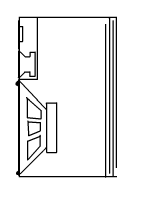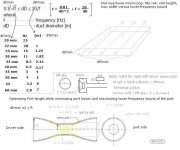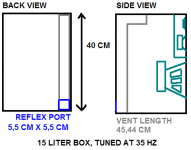I'm going to build 3-way speakers using subwoofer drivers for bass and my question is about bass reflex so I'm posting it here instead of multi-way forum.
I have calculated reflex tuning with winisd beta and tuning results in way too long reflex port to fit inside the enclosure.
I'm planning to build reflex port as rectangular version to be part of the enclosure. I have been thinking of building reflex port as labyrinth into the enclosure. I'm afraid that 180 degree turns affect tuning.
Is the reflex port in the picture incorrect way to build it into the enclosure? Does it ruin the reflex tuning somehow?
I have calculated reflex tuning with winisd beta and tuning results in way too long reflex port to fit inside the enclosure.
I'm planning to build reflex port as rectangular version to be part of the enclosure. I have been thinking of building reflex port as labyrinth into the enclosure. I'm afraid that 180 degree turns affect tuning.
Is the reflex port in the picture incorrect way to build it into the enclosure? Does it ruin the reflex tuning somehow?
Attachments
If the port is to scale please check your sims as the vent area looks small and you may get port chuffing.
The length of the port does put you into the realms of transmission line/horn enlosure design-if you are using BBpro you can "add port resonances" to your SPL output graph.
Give me the TS for the sub and proposed port area/length/box volume and I'll do some sims for you.
The length of the port does put you into the realms of transmission line/horn enlosure design-if you are using BBpro you can "add port resonances" to your SPL output graph.
Give me the TS for the sub and proposed port area/length/box volume and I'll do some sims for you.
The driver is peerless sls 6,5 inch type 830946
http://www.lautsprechershop.de/pdf/peerless/peerless_slsw639.pdf
The box in the picture is not in scale. It would be 10 liter box excluding the reflex port.
Tuning frequency would be 25Hz with reflex port: 182 mm x 12 mm opening resulting in length 95,80 cm.
I have already built two subwoofer-speakerstands in this fashion and I'm worried about tuning frequency of those too. Those subwoofers have peerless xls-10 and if I remember correctly in 40 liter box tuned at about 20 Hz, but excursion below 25 - 30 Hz increases worryingly instead of below 20 Hz.
http://www.lautsprechershop.de/pdf/peerless/peerless_slsw639.pdf
The box in the picture is not in scale. It would be 10 liter box excluding the reflex port.
Tuning frequency would be 25Hz with reflex port: 182 mm x 12 mm opening resulting in length 95,80 cm.
I have already built two subwoofer-speakerstands in this fashion and I'm worried about tuning frequency of those too. Those subwoofers have peerless xls-10 and if I remember correctly in 40 liter box tuned at about 20 Hz, but excursion below 25 - 30 Hz increases worryingly instead of below 20 Hz.
...Tuning frequency would be 25Hz with reflex port: 182 mm x 12 mm opening resulting in length 95,80 cm..
Hi Juupelila,
Have a look at this picture to see what is the rec. minimum slot-height for 25 Hz when no losses is expected:
b
Attachments
I'm going to build 3-way speakers using subwoofer drivers for bass and my question is about bass reflex so I'm posting it here instead of multi-way forum.
I have calculated reflex tuning with winisd beta and tuning results in way too long reflex port to fit inside the enclosure.
I'm planning to build reflex port as rectangular version to be part of the enclosure. I have been thinking of building reflex port as labyrinth into the enclosure. I'm afraid that 180 degree turns affect tuning.
Is the reflex port in the picture incorrect way to build it into the enclosure? Does it ruin the reflex tuning somehow?
There's a ton of things that affect frequency response with a port.
- Location of the mouth
- Location of the throat
- Is the mouth flared? The throat?
- What is the volume of the box?
The last one is probably the trickiest of all. Basically, as the volume of air in the box and the volume of air in the port get smaller, they become more resistive. And as they become more resistive, you get further and further away from the ideal behavior that's assumed by the model.
But there's good news!
You can sidestep all of these nightmares by just buying a Woofer Tester from Parts Express. Just measure the impedance curve and adjust the port accordingly.
The difference IS NOT subtle - I've seen boxes where I had to hack the port down by nearly half, or even worse, boxes where the port wasn't even behaving like a helmholtz resonator at all! The problem gets worse when ports get longer, or the box gets smaller, or both.
Vented boxes can be incredibly frustrating this way.
But the Woofer Tester is cheap, I couldn't live without it.
In that box with that port the first port resonance will be at 179Hz, so unless you are crossing HP to that driver lower than 80hz you will have problems. Second, the port ratio is 1:15 (height:width) which is way to high, 1:4 is generally the maximum ratio before you have to derate the port because of surface friction.
The real question is how high (Hz) will the bass driver be used? That will determine the longest port you can use before port resonances become a problem.
I suspect passive radiators will be the answer to your tuning problems. It almost always is when using a box that small.
The real question is how high (Hz) will the bass driver be used? That will determine the longest port you can use before port resonances become a problem.
I suspect passive radiators will be the answer to your tuning problems. It almost always is when using a box that small.
Thank you all for enlightening me about the matter. I truly appreciate new information. It is always great to learn something new.
I will be using active car crossover autostudio cxa-5e and crossover frequency will be 80Hz with 12db/octave.
Woofer tester and/or passive radiator exceed my budget so I can't use them in this project.
I would like get near flat bass response to at least to 40 Hz. Using closed box seems like a bad idea since electronic correction would require more amplifer power than I can afford. Still it seems like only way to achieve proper response.
I don't know enough about transmission line solutions to design them. Instead of flaring ends of reflex port I thought that leaving about 4 times the port diameter to both throat and mouth would be enough and making actual port diameter large enough to avoid chuffing.
Is the closed box way to go? What kind of box would you build for this woofer? (not restricting box volume) Are there better computer programs for designing subwoofer than winisd?
I will be using active car crossover autostudio cxa-5e and crossover frequency will be 80Hz with 12db/octave.
Woofer tester and/or passive radiator exceed my budget so I can't use them in this project.
I would like get near flat bass response to at least to 40 Hz. Using closed box seems like a bad idea since electronic correction would require more amplifer power than I can afford. Still it seems like only way to achieve proper response.
I don't know enough about transmission line solutions to design them. Instead of flaring ends of reflex port I thought that leaving about 4 times the port diameter to both throat and mouth would be enough and making actual port diameter large enough to avoid chuffing.
Is the closed box way to go? What kind of box would you build for this woofer? (not restricting box volume) Are there better computer programs for designing subwoofer than winisd?
I would like get near flat bass response to at least to 40 Hz.
Try ~15Liters tuned to 35Hz
"derate te port"
Hi there RV: Could you elaborate on the effect and procedure for "derating the port"? regards, ...Michael
In that box with that port the first port resonance will be at 179Hz, so unless you are crossing HP to that driver lower than 80hz you will have problems. Second, the port ratio is 1:15 (height:width) which is way to high,
1:4 is generally the maximum ratio before you have to derate the port because of surface friction.
The real question is how high (Hz) will the bass driver be used? That will determine the longest port you can use before port resonances become a problem.
I suspect passive radiators will be the answer to your tuning problems. It almost always is when using a box that small.
Hi there RV: Could you elaborate on the effect and procedure for "derating the port"? regards, ...Michael
Hi there RV: Could you elaborate on the effect and procedure for "derating the port"? regards, ...Michael
to start a definition: Derate: transitive verb: to lower the rated capability of (as electrical or mechanical apparatus) because of deterioration or inadequacy.
simple answer: In the case of a Helmholtz neck ie. port, you have airspeed vs. surface friction. Port output is limited by the free air (non turbulent) volume of the port. This is because the turbulent air (boundary layer) along the surface of the port walls becomes thicker the faster the air moves in relation to the surface. A high ratio say 1:16 (height:width) port has much more surface area than a low ratio port.
really simple answer: A narrow wide port will close up (compress/detune) at lower airspeed velocities than a square or round one.
revb.
Would there be any problems with this design?
15 liter effective volume (excluding reflex port etc) tuned at 35 Hz.
According to winisd alpha first port resonance would be at 378 Hz.
5,5 cm x 5,5 cm port with length of 45,44 cm making one 90 degree turn in the upper corner of the box.
Picture is not in scale.
15 liter effective volume (excluding reflex port etc) tuned at 35 Hz.
According to winisd alpha first port resonance would be at 378 Hz.
5,5 cm x 5,5 cm port with length of 45,44 cm making one 90 degree turn in the upper corner of the box.
Picture is not in scale.
Attachments
Would there be any problems with this design?
15 liter effective volume (excluding reflex port etc) tuned at 35 Hz.
According to winisd alpha first port resonance would be at 378 Hz.
5,5 cm x 5,5 cm port with length of 45,44 cm making one 90 degree turn in the upper corner of the box.
Picture is not in scale.
I see no problem as long as you don't send more than 25w to the LF driver.
To use the LF driver with 75w, 35Hz tuning, the port should be 10cm x 5.5cm x 84.5cm.
keep in mind the air velocity maximums are dependent on the size of the port, check out Flare-it - Free Speaker Design Software it's a handy little program.
- Status
- This old topic is closed. If you want to reopen this topic, contact a moderator using the "Report Post" button.
- Home
- Loudspeakers
- Subwoofers
- Labyrinth reflex port question


